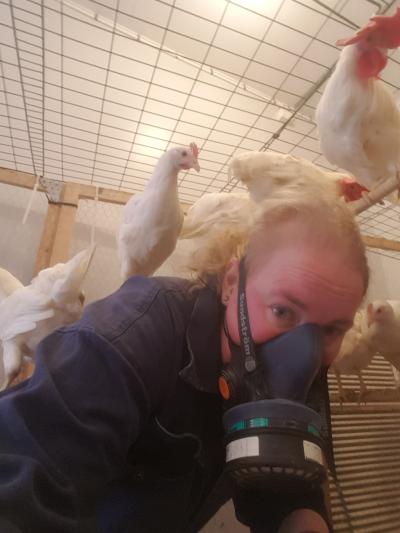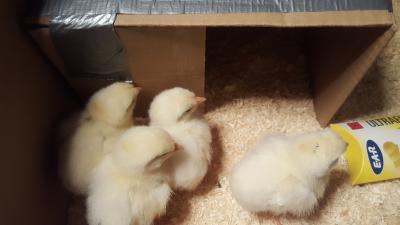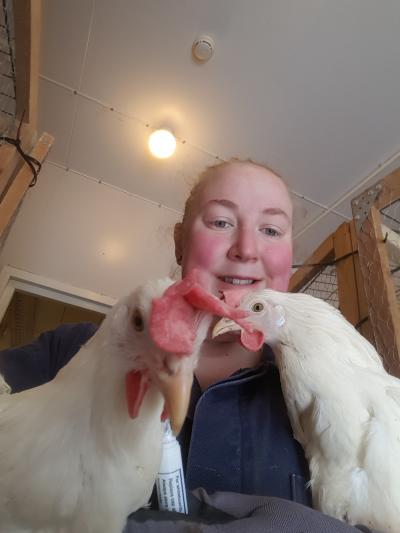Discussion
The present study found that hatchery routines caused high levels of CORT after incubation and completion of hatchery routines when compared with the control group. The acute effects of hatchery routines include; stronger CORT reaction, decreased exploration and comfort behaviours. The chronic effects include; stronger CORT reaction, increased feather damage, increased comfort behaviours in females, more eggs per day and higher estradiol levels. Comparing hatchery males to females: males performed fewer comfort behaviours at 2 days and 6 weeks, more vocalisations in TI at 6 weeks, and had increased feather damage.
Effect of hatchery routines

In the present study it was found that hatchery chickens had higher levels of circulatory CORT than the control chickens for both the incubation samples and the samples take after the hatchery process was completed. One possible explanation for the hatchery chickens having higher CORT levels than the controls after being removed from the incubator; could be that in the commercial hatchery the incubators are much louder than the incubators used to hatch the control chickens. Commercial incubators contain large fans to circulate the air evenly throughout the incubator, which as a result cause high levels of noise for the developing and hatching chickens. Research into the effect of noise on embryonic development in chickens appears sparse; Stadelman (1958) as cited by Campo et al., (2008), suggests that there are no effects of sounds below 96dB on the developing chickens. In contrast to this, when comparing variables between the incubation methods for each treatment group, the biggest difference between egg treatment appeared to be the level of noise in a commercial hatchery compared to a research hatchery. Further research into this could include measuring noise levels between the treatment groups, to give a more accurate comparison, especially considering that noise stress in adult birds has been shown to increase the heterophil to lymphocyte ratio when a treatment group exposed to high levels of noise (90dB) compared to control group which experienced only baseline levels of noise (65dB) (Campo et al., 2005).
The differences in CORT levels between the hatchery group after hatchery processing compared to the control group, which remained in their home pen since removal from the incubator, may be easier to explain than the incubation samples. During the hatchery process in the present study the stressed treatment group were subjected to manual manipulation multiple times, including; removal from hatching trays, wing sexing and vaccinations. This manual handling could be a source of stress for the hatchery treatment group. Handling of chickens during the hatchery process has been shown, in previous research, to increase levels of circulatory CORT in chickens (Ericsson and Jensen, 2016). Some companies have tried to eliminate this stress by almost completely mechanising the process with mechanical sorting of hatched chickens from egg shells, mechanical vaccination using either sprays or vaccinating in ovo, conveyer belt systems for transportation around the hatchery, and finally transported on ascending speed conveyer belts into an automatic chick counter. Full automation of the hatchery process means that the only time chickens would need to be handled manually would be when sex sorting (Appleby et al., 2004).
Although visually there was a difference in CORT levels between control and stressed chickens after transportation, this result was not statistically significant. One explanation for this could be that during the 3 hour transportation time between the commercial hatchery and the Linköping University (LiU) hatchery, the hatchery chickens may have become habituated to their transportation boxes. Another possible explaination to the non-significant levels of CORT after transportation is that by the time of arrival at LiU hatchery the stress experienced had caused a decrease in the level of circulatory CORT due to the negative feedback loop associated with the HPA-axis (Wang et al., 2014). In order to prevent overreactions to CORT which can cause injury, homeostasis must be re-established (Wang et al., 2013); as a result any further stressors may cause blunted activation of the HPA-axis (Morgan and Tronberg, 2007).
Acute effects of hatchery routines

Previous research has found that stress experience in early life can cause prolonged glucocorticoid release can have a plethora of acute negative consequences on development, including decreased weight, changes in metabolism, and increased fearfulness (Scanes, 2016). Contrary to the previous statement, in the present study it was found that the hatchery chickens weighed more than the control birds, not only initially, but for the duration of the study. Research into the effect of stress, more specifically the effect of CORT, on weight is very contradictory. Wang et al. (2013) found that administering CORT to broiler chickens water decreased the weight for the remainder of the experiment when compared to control groups which were not administered CORT. Another study found that, although there was no difference in the weight at hatch, between chicks which were injected with CORT in the egg and control, CORT injected chicks weighed less at both 1 and 4 weeks than control (Janczak et al., 2006). Both these studies contradict the findings in the present study.
One explanation for increased weight in the hatchery group could relate to a possible increase of feed efficiency due to early life stress. Gross and Siegel (1980) found that early life stress in chickens increased feed efficiency and increased weight for a line selected for low antibody reaction compared to a group selected for high antibody reaction. Increased feed efficiency in early stressed chickens would most likely account for increased weights. Further research into the effects of hatchery related stress could involve feed efficiency calculations by measuring the volume of food consumed by each treatment group.
Another possible explanation for hatchery individuals weighing more throughout the present study compared to the control chickens could relate to conditioning hormesis. Conditioning hormesis refers to exposure to mild stressors, in the present study this would be hatchery related stress, enabling an individual to be able to cope with subsequent exposures to stress more effectively than a control group (Constantini, 2014; Monaghan and Haussmann, 2015). This would suggest that by exposing chickens to hatchery related stress, they are more tolerant to stressors, such as behavioural testing, weighing and handling in later life than a control group. Therefore if the control group are less able to cope with stressors, it explains why they might weigh less than the hatchery group. The weight data in the present study further supports this notion due to an increase in the differences in weight between the hatchery group and the control group of chickens after all birds were moved from the hatchery facility to the adult chicken facility (at 5 weeks old), and after the second round of behavioural testing (at 6 weeks old).
Hatchery routines appears to have acute effects on the behaviour of chickens up to 1 week of age. In the present study when comparing hatchery chickens with control chickens by challenging them in a novel arena test, hatchery chickens appeared to show more fearfulness or stress when exposed to a novel environment. Hatchery individuals took significantly longer to emerge from the start box than the control chickens, in fact some hatchery individuals did not leave the start box for the entire duration of the experiment (n=8). This would suggest that hatchery individuals were more fearful of entering a novel environment. Hatchery individuals also distress vocalised and attempted to escape the arena at a higher rate than control chickens. Control chickens were more relaxed throughout the novel arena test compared to hatchery chickens, they performed more exploration behaviours, spent more time in a relaxed state, performed more comfort behaviours and transversed between different sections of the arena more frequently than hatchery chickens. These results would suggest that hatchery routines have an acute negative impact on the behaviour of chickens. A study conducted by Nicol et al. (2015) suggests that exploration and comfort behaviours in chickens are important indicators of not only negative welfare, but also positive welfare. Therefore, hatchery individuals performing less exploration and comfort behaviours suggests that they may have had their welfare compromised by hatchery routines compared to control chickens.
A similar occurrence was observed by Elfwing et al. (2015) in a study looking at the effects of early stress on open field behaviour. This study found that early stressed birds, particularly males, moved and explored in the open field less than non-stressed birds. This result was in contradiction to previous research within the same group by Goerlich et al. (2012) which found no effect of stress on open field behaviour. To further support the findings in the present study, it has been found that chickens treated with corticosterone performed a higher frequency of distress vocalisations during an open field test compared to a control group (Freire et al., 2006), this corroborates with the occurrence of a higher frequency of distress vocalisation performed by hatchery chickens in the present study.
The results of the first TI test conducted in the present study at 5 days old may also contribute to the hypothesis that hatchery individuals are have a stronger acute reaction to stress than the control chicken. Although there was no difference between the latency to righten and first head movement between control and hatchery treatments there was a tendency when comparing latency to first vocalise between males of both treatments. Upon visual inspection of the data it also shows that hatchery individuals had a longer latency to first vocalise than control individuals. This might suggest that control individuals began to wake from tonic immobility earlier than hatchery individuals, meaning they were less stressed than the hatchery individuals. In contrast to the present study, research conducted by Ericsson et al. (2016), found that an early stressed group had a shorter latency to righten and first move head compared with a control group. One possible explanation for the differences between the results from this study and the present is the stressor. In Ericsson et al. the stressor was food frustration on 2 separate days and social isolation for 2 separate days, in the present study the stressors received throughout the commercial hatchery process may have cause higher stress responses than the afore mentioned study. Elfwing et al. (2015) found that early stressed males during TI had a shorter latency to move their head than control males, suggesting that early stressed individuals do not respond similarly to control individuals in test measuring the effects of acute stress. The findings by Elfwing et al. also contract the findings in the present study that hatchery individuals respond more strongly to tonic immobility testing than control individuals.
The present study also supports the hypothesis that hatchery chickens are more stressed than control chickens during early life, through the results from the first restraint test at 7 days old. Hatchery individuals showed a higher level of circulatory CORT levels after restraint than the control individual. This shows that they have higher HPA-reactivity to a 3 minute restraint period than control chickens. This could be explained by either, hatchery chickens produce greater amounts of CORT in response to a stressor or they may have altered HPA-activity as a result of CORT exposure. Having fewer binding sites could be the result of early physiological changes due to the stress (elevated glucocorticoid levels) experienced within the commercial hatchery. A study conducted by Wang et al. (2013) explored the effect of CORT administration on gene expression relating to HPA-activity. In this study it was found that low TI broilers had increased numbers of glucocoticoid receptors in the hypothalamus, the main area contributing to the negative feedback loop in the HPA-axis. This insinuates that short TI broilers had a more efficient feedback when exposed to high levels of corticosterone. It is possible that exposure to stress from commercial hatchery routines in the present study altered the expression of HPA related genes, leading to the stressed chickens to have different HPA reactivity to the control chickens.
Chronic effects of hatchery routines

The chronic effects of hatchery routines appears to differ from the acute effects of hatchery routines somewhat. When looking at the results of the second novel arena tests conducted 6 weeks of age, there appears to be some stark differences between the results found from the first novel arena test conducted. Although visual inspection of the data showed that stressed chickens spent more time in the start box, this result was no longer significant. There were also no longer any observed differences between control and stress groups in regards to the amount of time spent exploring the arena after leaving the start box. In contrast with the previous novel arena test conducted at 2 days old, the second test conducted at 6 weeks old found that hatchery females performed comfort behaviours at a significantly higher rate than control females. However this result was not significant between males. This would suggest, somewhat, that hatchery females were less stressed by being placed in a novel environment than control chickens. This could be supported by the conditioning hormesis theory, exposure to early stress primed individuals for later stresses in life such as exposure to novel environments (Constantini, 2014). Drinking and running behaviours were only observed in control chickens. Drinking during a novel arena test may suggest that the control chickens were less stressed than the hatchery individuals, or simply that they were fulfilling the motivation of thirst whilst the stressed individuals were satiated before initiation of the experiment. Due to thirst being a basic biological function, with chickens only drinking when they are thirsty (Kyriazakis and Savoy, 1997, as referenced in Appleby et al., 2004), it may not be a reliable measure to compare behaviours between a stressed and control group. Running may be attributed towards exploration behaviours, or stress behaviours. An individual may run towards an item which interests them, or away from an aversive stimulus. In the case of this experiment, there were no recorded distress vocalisations or escape attempts from the arena suggesting that running may be an explorative rather than aversive behaviour. However when looking at explorative behaviour there was no significant difference between the amount of exploration between the hatchery chickens and the control chickens. It is possible that by 6 weeks of age, the immediate effects of the hatchery related stress are diminished and they react similarly to novel environments as the control group does.
The restraint test conducted at 6 weeks old yielded similar results to that at 7 days old with hatchery individuals having a higher level of circulatory CORT after a period of restraint than the control chickens. There was little difference between baseline CORT levels between treatments, suggesting there are no effects of hatchery routines on the level of CORT when not receiving a stress challenge. As previously discussed the difference in CORT reactions between treatments could be as a result of either the hatchery group releasing more CORT in response to a stressor or having a physiologically altered HPA-axis in which they do not uptake CORT to receptors at the same rate as the control chickens.
The results from the second TI test conducted at 6 weeks of age somewhat supports the findings from the second novel arena tests. Visual analysis of the data showed that control chickens appeared to have a longer latency to righten from tonic immobility test compared to the hatchery individuals, with a tendency between males. This suggests that control chickens may have a stronger stress response to acute stress than the hatchery chickens. This further supports the hypothesis that early stress within the commercial hatchery caused a conditioning hormetic effect and served to prime the chickens to deal more efficiently with additional sources of stress than non-stressed individuals. However when inspecting the data for vocalisation frequency hatchery males performed distress vocalisation at a much higher rate than control males, this contrasts with the results for rightening latency. This shows that there may be an effect of sex on stress response.
Another aspect the present study which supports the hypothesis that hatchery chickens are more stressed than control chickens is looking at feather condition. Feather condition is mainly linked with prevalence of feather pecking, a stereotypical behaviour heavily linked with stress. Therefore in the present study finding that hatchery chickens had poorer feather condition, increased prevalence of feather pecking, shows that they were likely more stressed than control chickens. In support of this hypothesis Kjaer and Guémené (2009) found that chickens selected for high feather pecking had increased levels of CORT reactivity compared to low feather peckers, this suggests that there is a link between these two factors. El-Lethy et al. (2001) also link increased CORT with a higher rate of feather pecking when administering CORT in feed.
When looking at the negative impacts of stress on commercial laying hens, research states that the presence of stress and negative welfare decreases production parameters such as egg production (Monaghan and Haussmann, 2015). Dei (2014) found that heat stressed chickens laid fewer eggs than those which were offered cold water to cool them, suggesting that heat stress negatively impacts production. In the present study it was found that there were differences in the number of eggs laid daily per hen in each pen. More eggs were laid per hen in pen 3 and 4 than both control pens (1 and 2), this may suggest that the hatchery chickens had a faster uptake of laying eggs than the control chickens. By the end of egg collection chickens in pen 2 were laying a similar amount of eggs as both of the treatment pens. However it is a possibility that the differences in the amount of eggs laid daily per pen could have been a pen effect rather than the effect of treatment. Considering all pens were treated similarly with equal lighting would give enough credence to the hypothesis that the hatchery chickens had a faster uptake of laying eggs than the control chickens. When critically analysing the data for egg weight, the present study showed that eggs became heavier over time. This result was as expected due to egg weight generally increasing from onset of lay at 20 weeks old to approximately 40 weeks old at peak production (Appleby et al., 2004). There was also a significant difference in egg weight between pens, with a tendency result in weight with pen 4 producing heavier eggs than pen 2. It is also possible that there may be an effect of pen on eggs weight rather than just treatment, however there is some research showing that early stress increases egg weight. One study that supports this hypothesis is Ericsson et al. (2016) found that out of three treatment groups; stressed at 2 weeks, stressed at 8 weeks and a control group, the group stressed at 2 weeks old laid heavier eggs than the other two treatments.
The results of the estradiol analysis showed that hatchery females had higher levels of estradiol at 19 weeks of age; this is considered point of lay for commercial chickens (Nicol, 2015). These results corroborate with the findings that hatchery related stress increases the number of eggs laid. This result contradicts reports that stress negatively impacts production factors (Monaghan and Haussmann, 2015). Research into stress and its effects on production factors has looked into temperature stress, both heat and cold stress negatively impacts egg production (Saint-Pierre et al., 2003; Mignon-Grasteau et al., 2015; Xie et al., 2017). A different story was shown when comparing testosterone levels, there was no statistical difference between treatment groups. This shows that hatchery related stress may have had no effects on male reproductive hormones; however there were significant differences between pens. Other factors such as number of males or females in the pen may have had an effect. The results of the present study contradict those of Elfwing et al. (2015) which found that early stress delayed sexual maturation in males; the reason for this difference may be due to not controlling for number of males and females in each pen, or having mixed sex pens.
Differences between hatchery males and females

One aim of the present study was to assess whether there was difference in the impact of hatchery routines when comparing males and females. There is zero selection on commercial laying chickens, as males are discarded at one day old if not being used as a parental bird and ex-laying hens do not get used as parental birds either (Nicol, 2015). Therefore it was unsure as to whether there would be differences between sexes. When analysing the results from the first novel arena test at two days old, hatchery females performed more comfort behaviours than hatchery males. This might suggest that hatchery males coped less well with high levels of stress during the commercial hatchery, than the hatchery females. Lower performance of comfort behaviours means that hatchery males’ welfare was more compromised than females (Nicol et al., 2015). The same result was found in the novel arena tests conducted at 5 weeks old, hatchery females performed comfort behaviours at a higher rate than males. This finding shows that the same behavioural pattern caused by hatchery related stress may persist over time.
Another result from the present study which supports the hypothesis that males are more susceptible to hatchery related stress than females was when analysing vocalisation frequency during the second tonic immobility test. Hatchery males performed vocalisations at a higher rate than females, this support that hatchery males were more stressed than females. However when looking at chronic effects of stress tonic immobility may not indicate differences due to chronic stress, because tonic immobility may measure more acute effects of stress. This being said, there is much research where tonic immobility tests correlate with other fear tests such as emergence tests and novel arena tests, additionally there are many studies supporting tonic immobility testing and its correlation with other stress parameters (Forkman et al., 2007).
Feather pecking has also been used as a stress parameter in commercial laying hen flocks and correlates with other production limiting factors (de Haas et al., 2013), the results of this study found that hatchery males had higher feather scores than hatchery females. A study by Jensen et al. (2005) contradicts this finding, suggesting a higher prevalence of feather pecking within females than males. One potential reason the results of this paper differs from the present study is that the chickens were not exposed to a strong early stressor such as the chickens in the present study. This supports the hypothesis that hatchery males had a stronger response to hatchery related stress compared to hatchery females
Responsible for this page:
Director of undergraduate studies Biology
Last updated:
05/27/18
